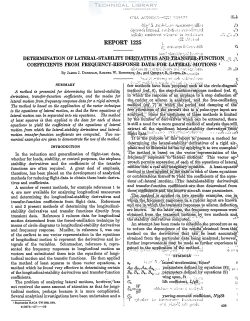naca-report-1225
- Version
- 179 Downloads
- 1.92 MB File Size
- 1 File Count
- November 2, 2016 Create Date
- November 2, 2016 Last Updated
National Advisory Committee for Aeronautics, Report - Determination of Lateral Stability Derivatives and Transfer Function Coefficients from Frequency Response Data for Lateral Motions

A method is presented for determining the lateral-stability
derivatives, transfer—function coefi’icients, and the modes for
lateral motion from fremtency-response data for a rigid aircraft.
The method is based on the application of the vector technique
to the equations of lateral motion, so that the three equations of
lateral motion can be separated into sin: equations. The method
of least squares is then applied to the data for each of these
equations to yield the coeflicients of the equations of lateral
motion from which the lateral-stability derivatives and lateral-
motion transferzfunction coefl'icients are computed. Two nu-
merical examples are given to demonstrate the use of the method.
In the reduction and generalization of flight-test data,
whether for loads, stability, or control purposes, the airplane
stability derivatives and the coefficients of the transfer
functions are often required. A great deal of emphasis,
therefore, has been placed on the development of analytical
methods for reducing flight data to obtain these basic deriva-
tives and coefficients.
A number of recent methods, for example references 1 to
4, are now available for analyzing longitudinal maneuvers
and determining the longitudinal-stability derivatives and
transfer-function coefficients from flight data. References
1 and 2 present methods of determining the longitudinal-
stability derivatives and transfer functions directly from
transient data. Reference 3 reduces data for longitudinal
motion determined from the forced-oscillation technique by
means of circle diagrams to longitudinal-stability derivatives
and frequency response. Mueller, in reference 5, was one
of the earliest to use vector representation in the equations
of longitudinal motion t6 represent the derivatives and in-
tegrals of the variables. Schumacher, reference 4, repre-
sented the frequency responses to longitudinal motion as
vectors and substituted them into the equations of longi-
tudinal motion and the transfer functions. He then applied
the method of least squares to these vector equations, a
method which he found very effective in determining certain
of the longitudinal-stability derivatives and transfer-function
coefficients.
| File | Action |
|---|---|
| naca-report-1225 Determination of Lateral Stability Derivatives and Transfer Function Coefficients from Frequency Response Data for Lateral Motions.pdf | Download |

Comment On This Post